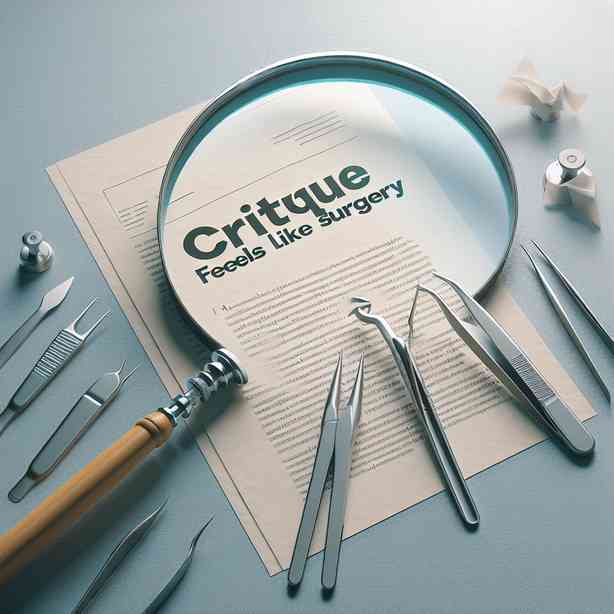
Critique, oftentimes perceived as a negative experience, actually resembles a vital surgery in the world of personal and professional development. Just as a skilled surgeon carefully navigates the complexities of the human body to remove detrimental elements and promote healing, critique operates to dissect ideas, talents, and narratives to foster growth and improvement. Understanding why critique feels like surgery can empower creators—whether writers, artists, or professionals—to embrace feedback as a necessary step toward refinement and success.
The initial discomfort associated with critique stems from our human instinct to protect ourselves. When someone evaluates our work, it can feel like an invasion of our personal space, much like a surgical procedure that requires cutting into skin. This metaphorical “cutting” exposes our vulnerabilities, but it is essential to recognize that just as surgery aims to heal, critique is fundamentally about enlightening and refining our efforts. The critique process involves identifying flaws and areas for enhancement, thus embarking on a journey that ultimately leads to better results.
To further understand this, we must consider the different layers involved in both critique and surgery. In surgery, before any procedure begins, there is a thorough assessment—diagnosis, imaging, and consultation take place. Similarly, in critique, a discerning eye scans through the work at hand. This phase is crucial, as it allows the critic to gather insights before delving into the feedback itself. Therefore, as the recipient of critique, understanding this preparatory stage can help one appreciate the thought process behind the feedback received. Just as surgeons strategize their approach, critics evaluate the best way to communicate their observations.
As we move deeper into the metaphorical surgical process, we encounter the actual operation—the manipulation of elements for positive outcomes. In the world of critique, this is where constructive feedback is delivered. What may feel like an incision, a sharp and jarring comment, is often a targeted suggestion aimed at removing detrimental aspects of a piece of work. In a surgical procedure, the surgeon works meticulously to minimize damage while enhancing functionality. Likewise, a well-delivered critique is honed to be specific, actionable, and nurturing, with the intent of not only pointing out flaws but guiding the creator toward productive changes.
The recovery process post-surgery is an equally essential component that mirrors the after-effects of critique. After undergoing surgery, a patient requires time to heal, often facing discomfort during recovery. Similarly, receiving critique can lead to feelings of vulnerability, doubt, or defensiveness. This emotional phase is natural; it is part of the process of growth. It is paramount, however, to allow oneself the opportunity to sit with this discomfort, acknowledging it, and using it as fuel for improvement. Like a surgeon instructs their patient to follow post-operative care, individuals receiving critique benefit from reflecting deeply on the feedback rather than dismissing it outright.
Critique, much like surgery, thrives within the realm of trust. Just as a patient trusts a surgeon with their body, creators must trust their critics with their ideas. This trust forms the foundation of a constructive critique environment. Critics who foster this trust will provide feedback that operates not from a place of judgment, but from a genuine desire to see improvement. Creators should seek out critics who possess understanding, experience, and the ability to convey their feedback compassionately. This synergy creates an atmosphere where critique transforms from a potentially painful experience into an instrumental part of the creative journey.
It is insightful to explore the notion that critique is not merely an end but a cyclical process. Following a critique, just as surgery may lead to follow-up consultations and adjustments, the feedback received often informs subsequent work. Engaging in this iterative process, where one creates, critiques, and re-evaluates, is fundamental to continuous improvement. This cycle fosters resilience; creators learn not only to handle critique with grace but also to view it as an integral component of their development.
In recognizing the parallels between critique and surgery, it becomes evident that both involve layers of complexity that should be respected. Embracing critique necessitates accepting that feedback serves a purpose greater than the discomfort it may initially bring. Like a surgical intervention designed to restore health, critique seeks to enhance the creator’s work. This understanding can cultivate a mindset that views critique through a lens of growth and opportunity rather than fear and rejection.
Moreover, we should encourage those around us to adopt a similar viewpoint regarding critique. By fostering a culture that supports open and respectful communication about creative work, we can mitigate the anxieties that often accompany the critique process. When we normalize discussions about feedback and the importance of ongoing refinement, we create an environment in which individuals can share their work without the looming specter of fear.
In conclusion, recognizing that critique feels akin to surgery helps us navigate the often turbulent waters of receiving feedback. By understanding the necessity of critique, we equip ourselves with the tools to embrace growth rather than resist it. Just as a well-executed surgery aims for healing, a well-structured critique aims for improvement. Approaching critique with trust, patience, and an open heart transforms it from a potential source of anxiety into a powerful catalyst for development. Each piece of feedback received is a step toward crafting a more polished version of ourselves and our work, a journey that, while sometimes painful, ultimately leads to greater fulfillment and success. Embracing this surgical aspect of critique encourages us to enter the creative arena not just as creators, but as resilient individuals committed to ongoing growth and excellence.


